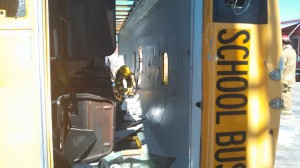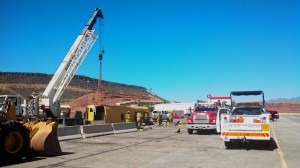
ST. GEORGE – The St. George, Hildale, and Cedar City fire departments and others met at the old St. George Airport for heavy-extraction training on Friday. In other words, they were trained in how to properly tear apart cars and buses with large saws and hydraulic jaws.

Beaver, Garfield, Iron, Kane and Washington counties make up Utah’s southwest region which is home to the Southwest Regional Response Team trained to handle a myriad of potentially hazardous situations. Formed in 2002 and funded by federal Homeland Security grants, three main teams – St. George Fire, Hildale Fire and Cedar City Fire – make up the body of the regional team.
Aside from the three main teams, members of the Hurricane and Washington Fire Departments also participated in Friday’s training.
“Our team does hazardous materials and technical rescue, wildland (fire) and EMS,” St. George Fire Battalion Chief Ken Guard said. “Technical rescue” consist of four categories: trench rescue, rope rescue, confined space, and heavy machinery – which was the focus the day’s training.
The group is on its second weekend of a two-weekend training that requires 40 hours of combined training and classwork. When the training is done, the firefighters become certified in not only the heavy machinery aspect of technical rescue, but also in how to instruct what they have learned with other fire departments throughout the region.
“We’ll take what we’ve learned as instructors and go out and bring everybody to a higher level of training,” Hildale Fire Chief Kevin Barlow said.
“This group will go out and teach (this) training to other fire departments.” Guard said. “That’s the plan.”
The regional trainings and the majority of the equipment used in them are primarily funded by the federal grants. Guard said the bulk of the costs for the current training was applied to the instructional-portion of the training, which ran around $9,000.

“Anytime they put ‘fire’ on something its read expensive,” Guard said. “Its even more expensive with they say ‘technical rescue.’”
While $9,000 may not seem like much, Guard pointed out the cost of equipment used during the training, as well as time and material donated by local businesses and entities to the Region Response Team training.
The Washington County School District donated two school buses to the training while the Dealer Collision Center and Zion Motors donated cars. Cars were also donated to the Hildale and Cedar City Fire Departments for use in the training as well. Ruesch Machine donated a crane with crane operator for a portion of the training.
The crane alone could have run as much as $1,000 an hour, Guard said, and he said he had no idea how what the buses and cars donated for the training could have amounted to.
As for the equipment used by the firefighters, Guard said the hydraulic jaws used for vehicle extrications are around $40,000 each. Additional hydraulic equipment is around $10,000. St. George, Hildale, and Washington each have the jaws and related equipment, all purchased through the federal grants. Guard also pointed out a fire engine at the training marked “Special Operations: Southwest Regional Response Team.” This fire engine costs $600,000 and has an additional $200,000 of specialized equipment on it. Cedar City Fire has a similar unit that cost $500,000. Again, each bought through the regional federal grants.
Guard figured as much as $25 million in federal grant money has been spent since the region’s creation in 2002. He also said he has seen the grants go down with each passing year.
Click on photo to enlarge it, then use your left-right arrow keys to cycle through the gallery.

Regional Response Team heavy-extraction training at the old St. George airport, St. George, Utah, Sept. 20, 2013 | Photo by Mori Kessler, St. George News

Regional Response Team heavy-extraction training at the old St. George airport, St. George, Utah, Sept. 20, 2013 | Photo by Mori Kessler, St. George News

Regional Response Team heavy-extraction training at the old St. George airport, St. George, Utah, Sept. 20, 2013 | Photo by Mori Kessler, St. George News

Regional Response Team heavy-extraction training at the old St. George airport, St. George, Utah, Sept. 20, 2013 | Photo by Mori Kessler, St. George News

Regional Response Team heavy-extraction training at the old St. George airport, St. George, Utah, Sept. 20, 2013 | Photo by Mori Kessler, St. George News

Regional Response Team heavy-extraction training at the old St. George airport, St. George, Utah, Sept. 20, 2013 | Photo by Mori Kessler, St. George News

Regional Response Team heavy-extraction training at the old St. George airport, St. George, Utah, Sept. 20, 2013 | Photo by Mori Kessler, St. George News

Regional Response Team heavy-extraction training at the old St. George airport, St. George, Utah, Sept. 20, 2013 | Photo by Mori Kessler, St. George News

Regional Response Team heavy-extraction training at the old St. George airport, St. George, Utah, Sept. 20, 2013 | Photo by Mori Kessler, St. George News

Regional Response Team heavy-extraction training at the old St. George airport, St. George, Utah, Sept. 20, 2013 | Photo by Mori Kessler, St. George News

Regional Response Team heavy-extraction training at the old St. George airport, St. George, Utah, Sept. 20, 2013 | Photo by Mori Kessler, St. George News

Regional Response Team heavy-extraction training at the old St. George airport, St. George, Utah, Sept. 20, 2013 | Photo by Mori Kessler, St. George News

Regional Response Team heavy-extraction training at the old St. George airport, St. George, Utah, Sept. 20, 2013 | Photo by Mori Kessler, St. George News

Regional Response Team heavy-extraction training at the old St. George airport, St. George, Utah, Sept. 20, 2013 | Photo by Mori Kessler, St. George News

Regional Response Team heavy-extraction training at the old St. George airport, St. George, Utah, Sept. 20, 2013 | Photo by Mori Kessler, St. George News

Regional Response Team heavy-extraction training at the old St. George airport, St. George, Utah, Sept. 20, 2013 | Photo by Mori Kessler, St. George News
Related posts
- No fire, just Santa Clara Fire Department training for ‘flash fires’
- DRMC, DSU hold mock mass-shooting exercise; STGnews Videocast and Photo Gallery
- Gunlock hopes to unlock funding for new firehouse
- Officials satisfied with Gold Cross service thus far, continue to evaluate
- Marine exercise: Good for the Corps, good for St. George; STGnews Videocast, Photo Gallery
- Dammeron Valley Fire achieves SSD status; improved service and opportunities
- Wildland-urban interface firefighting optimized through deliberate training; STGnews Videocast
- Public invited to open house for new dispatch training center; STGnews Videocast
- Washington County Emergency Operations Center installs backup radio antenna
- Emergency responders train for aviation casualties; STGnews Gallery
- Fire Department, National Guard hold WMD response exercises for Civil Support Teams
- When all else fails, Washington County Amateur Radio is there
- Not pulling over for emergency vehicles not only dangerous, but could cost drivers
- Pulsipher invites public participation in Sheriff’s Citizen Academy
- Washington City Public Safety tests new recruits for fire division
Email: [email protected]
Twitter: @MoriKessler
Copyright St. George News, SaintGeorgeUtah.com LLC, 2013, all rights reserved.




